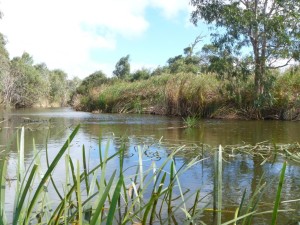
The Eastern Mount Lofty Ranges
Fish, flows and (mitigating) farm dams in a region of temporary streams
Temporary streams of the Eastern Mount Lofty Ranges (EMLR) represent outlying habitat at the terminal end of the Murray-Darling Basin, which maintains a diversity of habitats as well as connectivity with the River Murray and Lower Lakes. This region supports a diverse and unique native fish community but extensive water abstraction (namely >8000 farm dams) has reduced water availability and made many of the streams more temporary in nature (less flow for shorter periods of the year). Native fish communities have suffered with over half of the recorded species now considered nationally and/or regionally threatened. Impacts to flow regimes in the EMLR were exacerbated by the millennium drought between 1997 and 2010, particularly during the period of critical water shortage (2007-2010). Consistent with the broader region (lower Murray, Lower Lakes, Coorong), the EMLR experienced declines in stream flow and habitat availability and many identified populations of threatened fish were under threat. Significant rainfall and regional inflows over 2010 and 2011, increased stream flow and habitat condition improved.
Aquasave – NGT has a long history of monitoring and research in the EMLR, through baseline inventory sampling, assessment of environmental water requirements (REF) and targeted sampled of threatened species (REF). Since 2007, Aquasave – NGT has conducted annual (autumn) sampling of key populations of threatened species to assess condition (with detailed reporting carding every 3-4 years) with more intensive sampling was undertaken during the period of critical water shortage. Much of this work has been funded by Natural Resources SA Murray-Darling Basin (special thanks to Mardi van der Whelan).
Ongoing funding (and collaboration) from Natural Resources SA MDB will see the annual monitoring program continue into the future. Additionally, Aquasave – NGT are presently undertaking a review of the long-term fish monitoring dataset (over 837 individual site samples over 1999-2013), which will explore patterns across the region and with temporal changes (e.g. low flow, critical flow, flood and post-flood) as well as investigating the links between metrics of the flow regime and the recruitment and survivorship of two key threatened species (mountain galaxias and southern pygmy perch). This review will also include an updated assessment of the condition of key populations of threatened species.
- Reviewing the impacts of changing flows in the Eastern Mount Lofty Ranges 25/03/2018
- Busy field season in Mt Lofty Ranges and Lower Lakes 08/04/2016
- Paper reviewing Eastern Mt Lofy Ranges fish communities now available 12/12/2015
- Introducing… Aquasave – NGT projects in the Eastern Mt Lofty Ranges 04/12/2014

